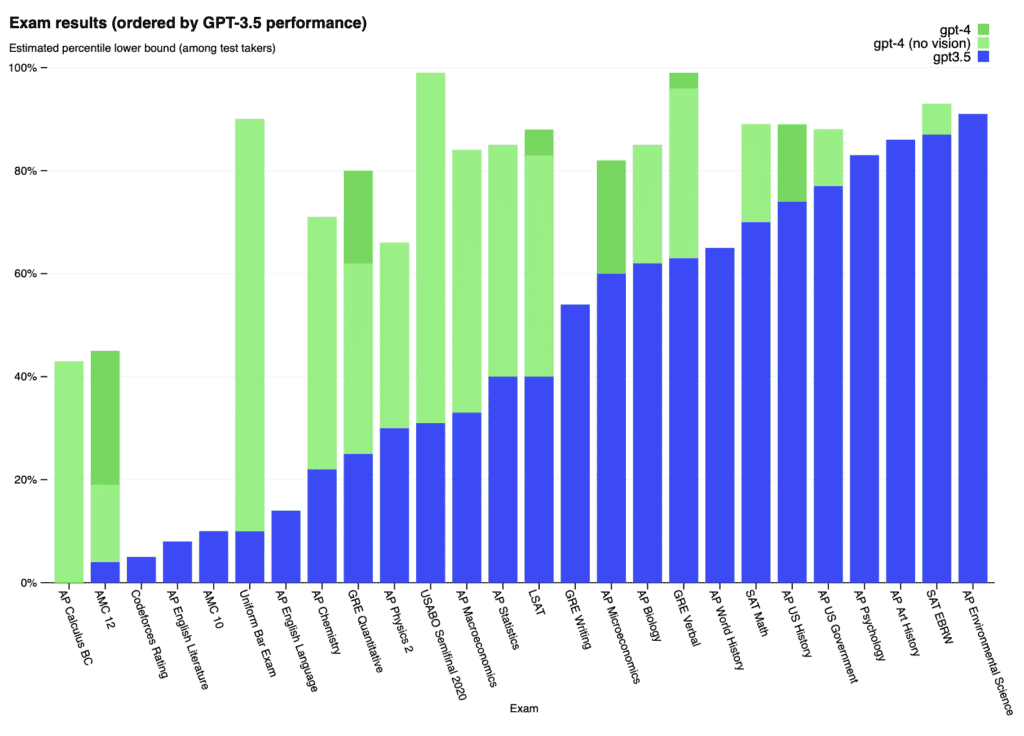ChatGPT-4 exam results compared to previous model.
ChatGPT-4 is here, on the heels of ChatGPT-3. What is new with this new edition of generative AI, and how could it benefit you?
AI is here to stay, for better or worse, and companies in all industries are scrambling to figure out how to leverage the technology to make their business more efficient.
OpenAI says: "We’ve created GPT-4, the latest milestone in OpenAI’s effort in scaling up deep learning. GPT-4 is a large multimodal model (accepting image and text inputs, emitting text outputs) that, while less capable than humans in many real-world scenarios, exhibits human-level performance on various professional and academic benchmarks."
What Can ChatGPT-4 Do Better?
ChatGPT-4 is known to be better than previous models at the following tasks:
- accept image input as well as text input
- taking exams such as the LSAT
- creating more reliable or creative results (sort of)
- outperform previous language learning models
- function in languages other than English
- steering the AI using "system messages" to guide output
ChatGPT-4 language learning model comparison.
OpenAI has programmed ChatGPT-4 to function in multiple languages beyond English, and allows users to program the AI to guide the experience of end users with "system messages" that help train the AI on desired results. The engine generates text outputs using image or text input, and can even accept inputs that are composed of interspersed text and images. Using documents with text and photographs or diagrams, GPT-4 shows a similar level of capability as it has on text-only input. This means that GPT-4 is significantly more impressive than many other AI image engines currently in existence. Image inputs are still in research stage and not publicly available, however, and the engine is still being trained for primetime.
When Can You Access ChatGPT-4?
OpenAI released the following statement with the announcement of ChatGPT-4:
"We are releasing GPT-4’s text input capability via ChatGPT and the API (with a waitlist). To prepare the image input capability for wider availability, we’re collaborating closely with a single partner to start. We’re also open-sourcing OpenAI Evals, our framework for automated evaluation of AI model performance, to allow anyone to report shortcomings in our models to help guide further improvements." The goal is to train ChatGPT-4 for optimal performance before releasing it into the wild to solve problems ranging from pattern recognition to marketing writing. ChatGPT and other generative AI bots are nowhere near as capable at nuanced thought and communication as humans, but the tool may prove useful under the right guidance for automating repeatable tasks such as creating writing templates, suggesting line items in a business plan, or sourcing ideas that can be followed up by human researchers.
The biggest downside? ChatGPT-4 still "hallucinates facts," meaning if you ask it to generate a blog article for you, the AI might just make things up as it goes along and cites no sources. Do not rely on AI to do fact-checking for you at its current state of capabilities. Upsides, however, include the additional capabilities to ask the AI to write text in a particular format requested, or in a particular tone with more reliable results (previously it might just spit out copyrighted content from the author you mentioned, rather than writing in the author's style).


